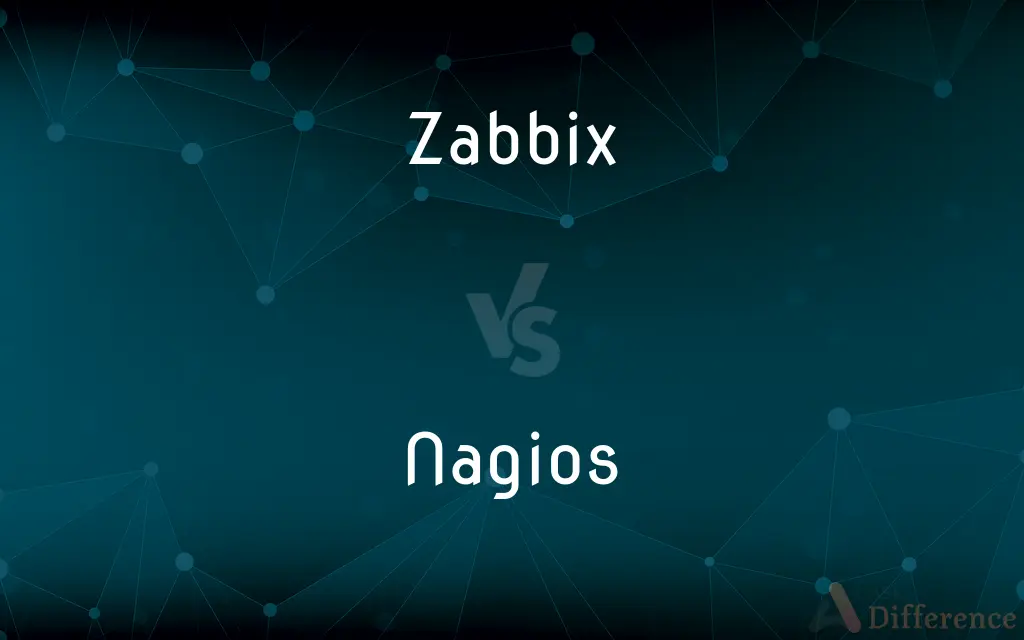Zabbix vs. Nagios — What's the Difference?
By Tayyaba Rehman & Urooj Arif — Updated on March 20, 2024
Zabbix offers extensive monitoring capabilities with a user-friendly interface, while Nagios is known for its robustness and flexibility through plugins.

Difference Between Zabbix and Nagios
Table of Contents
ADVERTISEMENT
Key Differences
Zabbix is an open-source monitoring tool designed for network and application monitoring, offering a comprehensive solution with built-in features like auto-discovery, real-time monitoring, and visualization options. On the other hand, Nagios is also an open-source monitoring solution, but it is particularly recognized for its robustness, flexibility, and a vast library of plugins developed by its community, allowing for extensive customization.
Zabbix provides a more intuitive and user-friendly interface compared to Nagios. This makes it easier for new users to navigate and configure their monitoring environment. Whereas Nagios, despite its steep learning curve, offers unmatched flexibility that allows users to tailor the system to their exact needs, albeit with more effort involved in configuration and maintenance.
When it comes to setup and configuration, Zabbix is generally considered to be easier and quicker to deploy because of its auto-discovery feature, which automatically detects network devices and configurations. Conversely, setting up Nagios can be more time-consuming and complex, requiring manual configuration of each monitored element, but this also means it can be fine-tuned to a greater degree.
Zabbix uses a database to store monitoring data, which facilitates historical data analysis and reporting directly from its dashboard. Nagios, while capable of integrating with databases for data storage, traditionally focuses more on current status monitoring and alerts, relying on additional plugins for historical data analysis.
Both Zabbix and Nagios support a wide range of notification methods, including email and SMS, and can monitor various network services, host resources, and applications. However, Zabbix's built-in support for newer technologies like cloud, virtualization, and web monitoring is more extensive, whereas Nagios might require additional plugins for such functionalities.
ADVERTISEMENT
Comparison Chart
Core Functionality
Comprehensive monitoring with auto-discovery and real-time data.
Robust monitoring with extensive customization through plugins.
User Interface
User-friendly and intuitive.
Less intuitive, with a focus on flexibility and customization.
Setup and Configuration
Easier and quicker to deploy, with less manual configuration.
Time-consuming setup with manual configuration for each element.
Data Storage and Analysis
Uses a database for easy historical data analysis and reporting.
Focuses on current status and alerts, with plugins for analysis.
Support for New Technologies
Extensive built-in support for cloud, virtualization, etc.
Requires additional plugins for monitoring newer technologies.
Compare with Definitions
Zabbix
Built-in database for historical data.
Zabbix allows easy access to historical monitoring data.
Nagios
Highly customizable monitoring solution.
Nagios' strength lies in its flexibility through plugins.
Zabbix
Quick deployment with auto-discovery.
Zabbix can be set up with minimal manual configuration.
Nagios
Manual and detailed configuration needed.
Each element in Nagios must be manually defined for monitoring.
Zabbix
Offers real-time network and application monitoring.
Zabbix automatically discovers network devices for monitoring.
Nagios
Relies on plugins for data analysis.
Historical data analysis in Nagios may require additional plugins.
Zabbix
Broad support for modern technologies.
Zabbix monitors cloud and virtual environments effectively.
Nagios
More complex, focusing on customization.
Nagios requires more effort to navigate and configure.
Zabbix
Features a user-friendly dashboard.
Users can easily navigate and configure Zabbix through its GUI.
Nagios
Extensive with the right plugins.
Monitoring new technologies in Nagios often requires specific plugins.
Zabbix
Zabbix is an open-source monitoring software tool for diverse IT components, including networks, servers, virtual machines (VMs) and cloud services. Zabbix provides monitoring metrics, among others network utilization, CPU load and disk space consumption.
Nagios
Nagios Core , formerly known as Nagios, is a free and open-source computer-software application that monitors systems, networks and infrastructure. Nagios offers monitoring and alerting services for servers, switches, applications and services.
Common Curiosities
How do Zabbix and Nagios handle notifications?
Both support various notification methods, including email and SMS, for alerting administrators about issues.
Which is easier to set up, Zabbix or Nagios?
Zabbix is generally considered easier and quicker to set up due to its auto-discovery feature.
Do Zabbix and Nagios offer community support?
Both have active communities that provide extensive support, documentation, and plugins.
How do updates and maintenance compare between Zabbix and Nagios?
Both platforms are regularly updated. Zabbix's user-friendly interface can make maintenance easier, while Nagios may require more manual intervention.
Can I customize the dashboard in both Zabbix and Nagios?
Yes, both offer customizable dashboards, but Zabbix is known for its more intuitive and user-friendly customization options.
Which is more cost-effective, Zabbix or Nagios?
Both are open-source and free, but the total cost of ownership can vary based on the need for custom plugins, configuration, and maintenance efforts.
Can Nagios monitor cloud and virtualization technologies effectively?
Yes, but it often requires additional plugins to monitor such technologies effectively.
Is Zabbix suitable for large-scale environments?
Yes, Zabbix is well-suited for large-scale environments, offering scalable monitoring options.
Can I migrate from Nagios to Zabbix?
Yes, migration is possible, but it involves planning and consideration of the differences in monitoring philosophy and configuration between the two systems.
What is the main difference between Zabbix and Nagios?
Zabbix is known for its comprehensive, user-friendly monitoring capabilities, while Nagios is valued for its robustness and extensibility through plugins.
Share Your Discovery

Previous Comparison
Bush vs. Shrub
Next Comparison
GET vs. POSTAuthor Spotlight
Written by
Tayyaba RehmanTayyaba Rehman is a distinguished writer, currently serving as a primary contributor to askdifference.com. As a researcher in semantics and etymology, Tayyaba's passion for the complexity of languages and their distinctions has found a perfect home on the platform. Tayyaba delves into the intricacies of language, distinguishing between commonly confused words and phrases, thereby providing clarity for readers worldwide.
Co-written by
Urooj ArifUrooj is a skilled content writer at Ask Difference, known for her exceptional ability to simplify complex topics into engaging and informative content. With a passion for research and a flair for clear, concise writing, she consistently delivers articles that resonate with our diverse audience.
















































